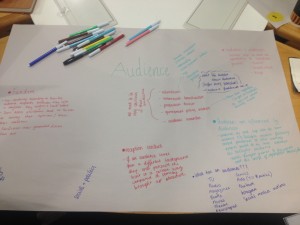AUDIENCE
In this lecture, Brian Morris outlines different types of audience: Television Audiences – from broadcast to Post Broadcast, Active Audience theories, Thinking about Taste Cultures, Fans and Fandom and New Media audience.
A way of looking at media changed in the eighties thanks to semiotics, representations of women, particularly the Madonna phenomena and the reflexiveness of the viewer back and narrative. This is shown in a scene in Simple Men, Hal Hartley (1991) where the main character discuss Madonna, objectification of women and whether it has been reclaimed by women.
‘I CAN’T STAND THE QUIET!’ Martin Donovan, Simple Men.
In reality, while scholars considered these issues, teenage girls had a completely different experience and instead mimicked their idol. Here we can the gamble of communication where the intended viewer has re-coded the message.
Post Broadcast Era
Advertisers are particularly interested in audience for obvious reasons in that they need to know who is their target audience to sell products to. Because media now is so diffuse, post broadcast, it is difficult for advertisers to target their brands to specific groups.
Here is a basic chart of the ‘MEDIA EFFECTS’ THEORY’:
•anxiety/suspicion re TV’s power • audience is passive / manipulated/ brainwashed • lab experiments, focus groups, playground observations
The Passive Audience
The audience are complicit in their own inactivity or questioning of content.
IDEAS OF ‘MASS CULTURE’ & ‘MASS AUDIENCES ’ -T. ADORNO & M. HORKHEIMER, THE CULTURE INDUSTRY (1963)
‘Real life is becoming indistinguishable from the movies. The sound film, far surpassing the theatre of illusion, leaves no room for imagination or reflection on the part of the audience, who is unable to respond within the structure of the film, yet deviate from its precise detail without losing the thread of the story; hence the film forces its victims to equate it directly with reality. The stunting of the mass-media consumer’s powers of imagination and spontaneity does not have to be traced back to any psychological mechanisms; he must ascribe the loss of those attributes to the objective nature of the products themselves, especially to the most characteristic of them, the sound film. They are so designed that quickness, powers of observation, and experience are undeniably needed to apprehend them at all; yet sustained thought is out of the question if the spectator is not to miss the relentless rush of facts.’
IDEAS OF ‘MASS CULTURE’ & ‘MASS AUDIENCES ’
‘There are in fact no masses; there are only ways of seeing people as masses … a way of seeing people which has become characteristic of our kind of society … [a way of seeing that] has been capitalised for the purposes of cultural or political exploitation’. R. WILLIAMS, CULTURE AND SOCIETY (1963)
This quote is best exemplified in The Network (1976) where the audience is being commented on, projected to while the protagonist, why trying to be an agent of change, is exploited by the very thing he represents.
https://www.youtube.com/watch?v=H-umBOdafbs
‘Fans [are] often stereotyped and pathologised as cultural “Others” – as obsessive, freakish, hysterical, infantile and regressive social subjects. Pop culture’s take on fandom has typically been one of distaste and critique, with fans’ emotional attachments to media texts and celebrities being viewed as “irrational” ‘… M.Hills (2007)
Fans like Trekkies, Whovians and Thronians, appropriate their favourite content and are, as Henry Jenkins points out in Textual Poachers (1992) ‘active producers and manipulators of meaning’ and [find] pleasure in aspects of the text that are not necessarily valued by producers/ those with institutional training.’ This emergence of ‘participatory culture’ is the result of new technologies such as social media, subcultures like fan clubs and fanzines and event fandom where cosplayers perform to other fans.
Online fan communities in particular have had a reflexive effect where they have been able to lobby a series to come back on (Doctor Who) or to keep it on air (Joss Wheedon’s Firefly). They have become ‘prosumers’ – blurring the line between producers and consumers with user generated content.
The people formerly known as the audience are simply the public made realer, less fictional, more able, less predictable. You should welcome that, media people. But whether you do or not we want you to know we’re here.
Jay Rosen (2006),’The People Formerly Known as the Audience’, PressThink blog, June 27G
Fans, in short, recreate are another narrative, each either adhering to the new norms of narrative imposed by the status quo of their group or appropriating characters and then authoring their own fandom. They are also no longer a marginal socially inept group but have become mainstreamed.
REFLECTION
This lecture was invaluable to myself and my collaborators as our project is Audience, choosing Cosplayer fandom as our subject. What Henry Jenkin’s has talked about in Textual Poaching is relevant to us as we explore the expression of fans: from cosplaying, online communities and trolling.
I quite enjoyed seeing ‘Simple Men’ as I remember seeing it when it first came out and recall that reflecting the discussions at the time was something that was echoed in films, especially in Tarantino’s work. Like the fandom we have set to explore, fans will appropriate content for their own means and police those who do not fall into the rigidity of imposed codes. An example of this is with cosplaying and their attention to an authentic costume.
Below is another idea that fandom can actually infantilise people, in the documentary below, ‘The Men Who Made Us Spend’.







